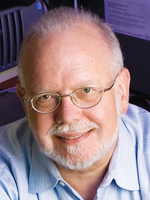June 2019—Analyzers, menus, test distribution, and middleware were the topics of a roundtable led in April by CAP TODAY publisher Bob McGonnagle. Samuel McCash, MD, Frederick Kiechle, MD, PhD, Christina Reita of Roche, and Mimi Dang of Tosoh talked IT, turnaround time, and what challenges stand out. Here is what they told us. Click to view CAP TODAY’s guide to chemistry and immunoassay analyzers for the POC and low-volume markets.
Dr. McCash, tell us about your practice at Memorial Sloan Kettering and what now is top of mind for you.
Samuel McCash, MD, director of 53rd Street Clinical Laboratory, Department of Laboratory Medicine, Memorial Sloan Kettering Cancer Center: I am director of three outpatient laboratories and assistant director at our main laboratory. We want to make sure our precision and sensitivity are similar across our outpatient labs and main campus, keeping results comparable regardless of which site runs the tests. Also, results have to be sufficiently accurate for chemotherapy-related calculations.
Christina Reita, we associate with the large chemistry manufacturers like Roche the idea that you have members of a family and, in particular, models within that family that are suitable for all kinds of labs and their applications, all running on one system. Can you tell us about the evolution of that at Roche and how important an initiative it has been to have one model in many capacities?
Christina Reita, vice president, centralized diagnostics, Roche Diagnostics: Laboratories are consolidating into ever growing integrated health networks. Their diagnostic purchasing decisions are increasingly made by committees, so they face the challenge of when and what testing to centralize versus decentralize. This is an area we have focused on largely through our commitment to research and development.
We were pioneers in modular systems and continue to offer the only integrated, standardized solution. This means that no matter the platform or the reagents, we have the same package insert claims, the same sensitivities, specificities, and measuring ranges that laboratories expect so that when the cancer patient, to use Dr. McCash’s example, who was at the main facility is then tested for creatinine levels at an outpatient facility, the results are standardized.
As I see it, there are two key benefits to having this kind of installation. First, technical personnel are trained so they can easily go anywhere within a system and operate the test. The second is the importance of establishing a systemwide reference range. Dr. Kiechle, can you speak about the importance of one standard reference range across a system?
Frederick Kiechle, MD, PhD, consultant, clinical pathology, Cooper City, Fla.: What’s important has been addressed, and that is to find instrumentation manufactured by the same company that has the same methodology, the same issues, no matter which machine you’re putting the test on—high, medium, or low volume.

Dr. Kiechle
Also important in deciding what kind of equipment to place at large, medium, or small institutions is turnaround time. It depends on how far away the centralized lab is from the smaller institutions. The longer the transportation time, the more tests you’re going to have to do at the smaller site. The quicker the transportation time, the smaller the number of tests. If the institutions are close enough, say across the street from each other, that will affect how to split menus and instrument decisions.
There’s also the concept of sharing expertise. It is popular in Canada but doesn’t work as well in the United States. Here it makes more sense to look at the question of turnaround time, and then beyond that, what is clinically needed in that particular smaller institution that is not necessarily requiring a fast turnaround time but is essential to moving patients around. For example, TSH may not be considered a decisive lab test for most hospitals. However, in an emergency department with an elderly population, TSH is the primary test. It might turn a patient into an inpatient or an outpatient.
Mimi Dang, what is top of mind for your current customers and those who are making inquiries of you for your instrumentation, particularly in immunoassay? Do you see some shifting? What’s the latest in terms of what you’re hearing from customers and what you’re trying to develop within your R&D structure?
Mimi Dang, associate product manager, Tosoh Bioscience: With our customers it is about having similarity across all the instruments. Tosoh offers a solution for all testing volumes, and because we use the same reagents across the platforms, it offers the standardization.

Dang
Customers want a wide range of immunoassays with minimal waste. For esoteric assays they want the flexibility of single use tests to optimize their reagents.
They want an analyzer or reagent that takes away the errors that can happen in immunoassays, for example reconstituting reagents and worrying about stability, calibration, and interferences. Tosoh R&D is working on the next generation of immunoassay reagents and analyzers to meet these needs.
Most of our customers are looking for not only the high- and medium-volume analyzers but also the smaller ones, where it can be intraoperative, so if they do need stat testing, it can occur on the floor.
While we talk about the need for a family and similarity across systems, we also have a kind of best-of-breed question that seems to come up when we talk about certain analyzers. For example, I know laboratories where they like immunoassay system A for nutrition and anemia markers, system B for cancer biomarkers, and system C for general immunoassay tests.
Dr. McCash, do you adopt that philosophy at Memorial, whereby you have some analyzers that are very dedicated because they may be best for a certain subset of tests, irrespective of the need to standardize across the system on large mainframes?
Dr. McCash: Yes, we do have a variety of analyzers for immunoassays, particularly when looking at tumor markers, hormones, that sort of thing. They were selected because of certain parameters—analytical sensitivity, for example. How low can they go, how low can they measure and still be accurate, because some of our clinicians want to have a number to look at, but it is also research related.
However, that can change over time, and other factors come into play, such as turnaround time. They want to know right away with some chemotherapies if the patient is at toxic levels or if they’re below the therapeutic window so they can act on it immediately. Even though there may be tests that have higher sensitivities or specificities, we may prefer a system that is faster.
We’re also always looking at where we can consolidate. To meet desired turnaround times we try to move manual and more specialized tests to the automated instruments our technologists are already familiar with. We willingly look at any test we can move to one of our more automated systems that allows us to run the tests 24 hours a day.
Dr. Kiechle, I’m hearing a desire to standardize on the fewest systems that get the work done reliably and at the clinical quality levels that are demanded, not only within the lab but also by the clinicians who are using the results. But based on what Dr. McCash says, is there still a need to evaluate individual systems and their individual assays and performance characteristics in order to get the optimum testing situation established in a laboratory?
Dr. Kiechle: I worked with two large hospital integrated systems, and the usual issues that come up are for those tests that are more esoteric, those ordered less frequently. They come stat; you have to sit down and think about what is this machine and its tests and are they available 24/7, and often that’s not the case. For example, if you’re doing immunosuppressive drugs in a special chemistry lab, and that lab is open only for about a shift and a half and the rest of the 24-hour period is not covered, and someone comes in and has a need for a stat drug level to assess transplant rejection issues.
You want to have your best machines for these esoteric tests located in your centralized lab and have a rapid way to get those specimens to that central location. If you have to decentralize that process, you have to be careful that the technology, the training, is spread equally across the system so everyone is functioning at the same level.
Immunoassay used to be a method, but now it’s becoming a place, and once it does, it’s difficult to move it and decentralize it. Molecular tests are a place and soon they will be decentralized to the point where you will hardly recognize it. It’s something we need to watch out for as we plan.
Then there’s the issue of having selected a main chemistry system—and guess what? It does troponin I. But there’s no high-sensitivity troponin I available, and my cardiologist is saying, “I want this Roche troponin I assay I’m hearing about, and I want it now.” You have to make a decision about whether to buy a small Roche device to handle that issue or a more medium-size immunoassay instrument.
Another issue is the PTH assay, which is often performed intraoperatively. This is an assay for which there was technology at one time that you put on a cart and rolled into the operating area. In the large hospital system I worked in, we did not have it on a cart. We had the OR test done manually in the central lab where we did the most rapid testing we had available on our automated equipment. There are challenges to each alternative.
Human chorionic gonadotropin is another; it needs to be done on women suspected of having ectopic pregnancies. Do not waste your time on a urine test and call it a rapid turnaround time test with a sensitivity that is much less than the central laboratory test.
Beware that kind of rationalized criticism, because now physicians are expecting a serum test to be the same sensitivity throughout their universe of experience, which is one high-sensitivity assay. Now you introduce one with intermediate sensitivity and they don’t know how to use it. And they shouldn’t use it. You use a urine test for that, and not the serum test.
There are pitfalls along the way of trying to find the right fit for the right test, the right time, the right location.
It’s clear this is an enormous area that requires a lot of experience and analysis, and even a lot of working out exactly how your test menu will be set up with what analyzers in which places, and even which methods, as Dr. Kiechle mentions. What do you do at Tosoh to help laboratories with these decisions?
Mimi Dang: Our team is made up of different technical groups. These teams work with the customer to identify what’s the best workflow. Because Tosoh has different models of analyzers, we can customize the solution based on the needs of the laboratory. Our analyzers use the same reagents across platforms, which allows for the standardization of the tests, whether it’s in the core lab, ER, surgical suite, or a satellite lab. This is what is appealing to our customers.
We also train the customers on the clinical utility of the tests and the current trends in the market, whether it is interferences in the immunoassays or standardization of assays.
How does Roche help a laboratory work through these questions around analyzers, test distribution, menu, and critical assays?
 CAP TODAY Pathology/Laboratory Medicine/Laboratory Management
CAP TODAY Pathology/Laboratory Medicine/Laboratory Management
